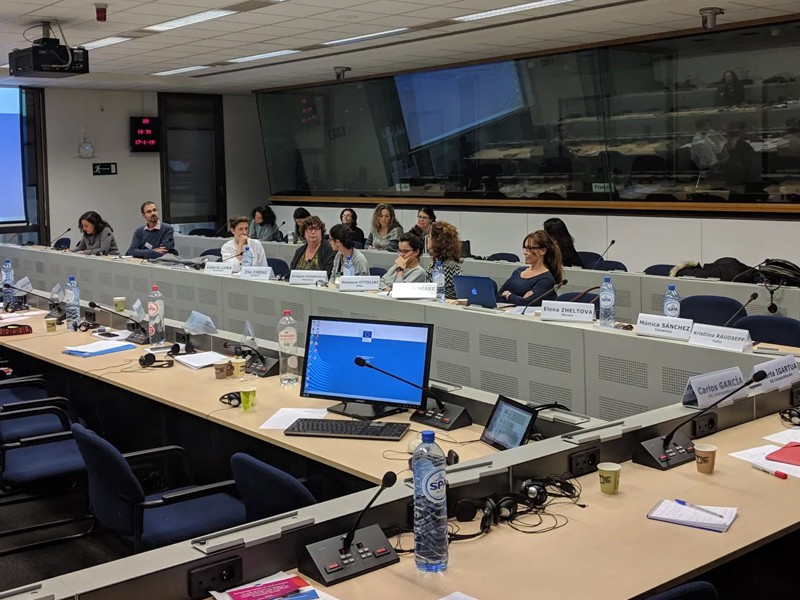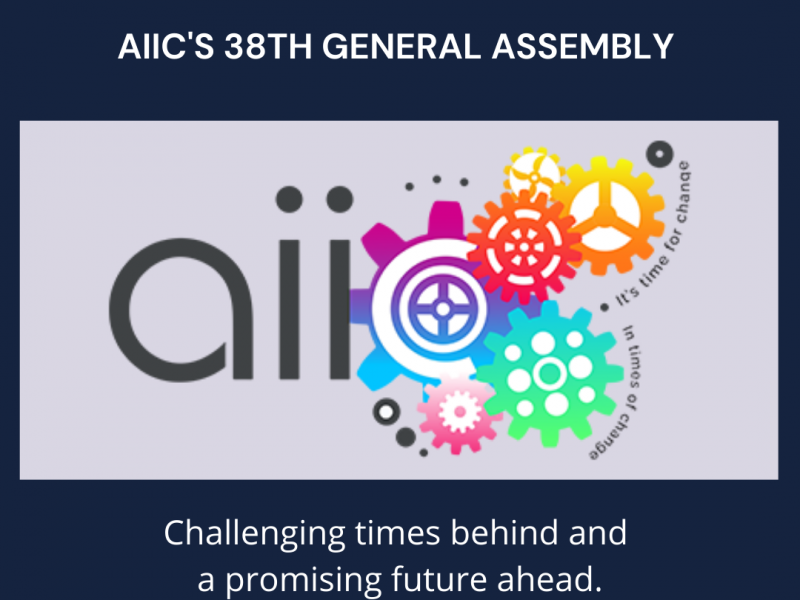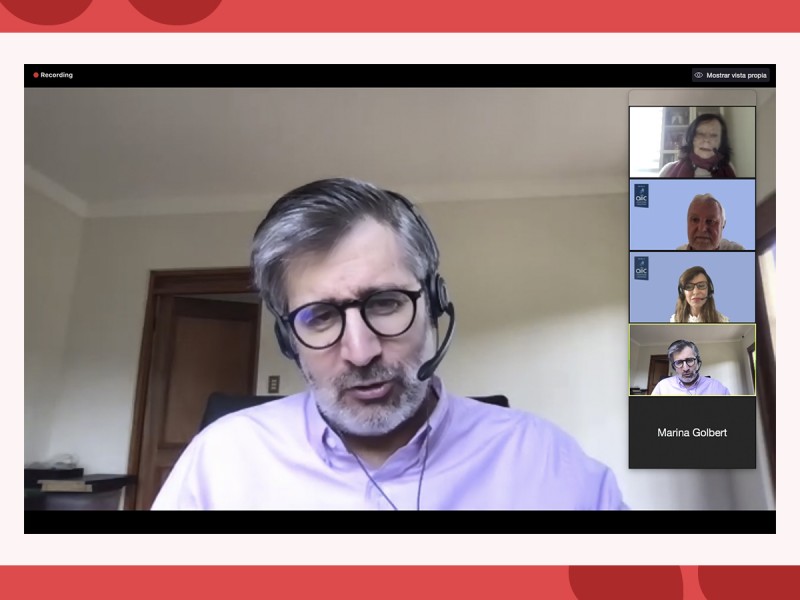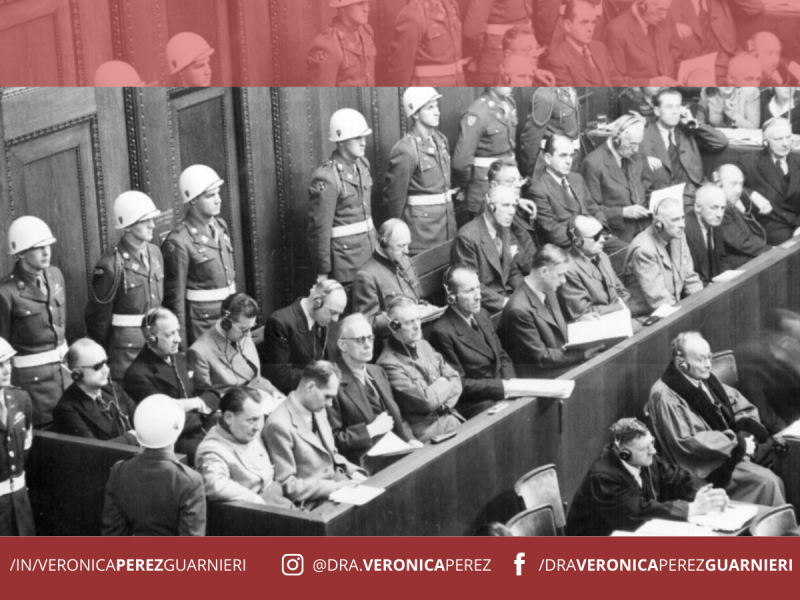Del 14 al 18 de enero de 2019, tuve el honor de participar del Primer Curso para Formadores de Intérpretes de Español organizado por la Dirección General de Interpretación de la Unión Europea (SCIC)en la sede del Centro de Conferencias Albert Borchette (CCAB). Fui invitada como Directora del Posgrado sobre Interpretación que se abre este año en la Universidad Católica de Salta.
La capacitación se extendió durante cinco días de intenso trabajo. Con especialistas en la formación de intérpretes para la Unión Europea, recorrimos el camino pedagógico recomendable para todo programa de formación de intérpretes: desde la selección de los candidatos ideales hasta el examen final.
Los contenidos que se presentaron fueron de gran riqueza, y, en esta nota, se desarrollan los temas clave sobre los que se articuló este curso: el perfil de los futuros intérpretes, la progresión pedagógica, la preparación de los discursos, la organización de los contenidos de las clases, las formas de capitalizar las evaluaciones en devoluciones positivas y los recursos informáticos que aceleran la tarea de interpretar.


Candidatos
La tarea de un intérprete exige asumir grandes responsabilidades. Una interpretación deficiente puede conducir al desprestigio del orador o de la institución que lo respalda, al fracaso de un negocio, incluso, a un conflicto internacional. Por esa razón, es fundamental contar con intérpretes que tengan determinadas condiciones para desempeñar su profesión.
Respecto de los exámenes de admisión, se analizaron las opciones más adecuadas para valorar las cualidades que se espera de cualquier potencial intérprete: capacidad de concentración, rapidez de reacción, capacidad de análisis y síntesis, amor por los idiomas, curiosidad intelectual, resistencia a la presión, prudencia, conocer cuál es su lugar en todo momento, trabajo en equipo, comunicación y madurez intelectual.
Para algunos especialistas, el intérprete debe cultivar y emplear cuatro competencias: lingüísticas, pragmáticas, enciclopédicas y estratégicas. Se entiende por la competencia lingüística el conocimiento especializado de las reglas gramaticales con enfoque normativo, las cuales abarcan la fonemática, morfología y sintaxis de la lengua. Sobre la competencia enciclopédica, se puede decir que, en la medida en que el conocimiento previo sobre el tema de la disertación que se interpreta sea mayor, es más fácil de traducir y detectar aquello que se da por sentado mediante procesos de inferencia. La competencia pragmática permite comprender funcionalmente lo que ocurre cuando un orador se expresa ante un público y, por lo tanto, le brinda al intérprete la posibilidad de reflexionar sobre la pertinencia de determinadas formas. Finalmente, la competencia estratégica, donde se incluyen capacidades concretas, verbales y no verbales, para superar obstáculos, como las deficiencias sistemáticas de los hablantes, o para reforzar la eficacia comunicativa.
Por esta razón, en este Primer Curso para Formadores de Intérpretes de Español, se analizaron los medios para valorar dichas cualidades y competencias en los futuros intérpretes. Se describieron las siguientes estrategias de evaluación:
a) EXAMEN ESCRITO
- Examen tipo test para mediar la cultura general.
- Composición en los idiomas de trabajo.
- Comprensión auditiva por cuestionario.
- Examen de idiomas.
- Traducción a primera vista a la lengua A y B (sobre un texto corto de actualidad).
b) ENTREVISTA ORAL
- Entrevista para evaluar expresión al español y al inglés, o a los demás idiomas de trabajo.
- Preparación de un discurso sobre un tema de actualidad.
- Presentación de un resumen detallado sobre lo que se escuchó de un discurso en sus lenguas de trabajo.
Progresión pedagógica
Como los conocimientos se adquieren de manera paulatina y constante, uno de los factores más importantes en la formación de un intérprete es la progresión temática sobre la cual se construye la currícula. Siempre es conveniente partir de los procesos más simples de realizar y culminar con la integración de todos los métodos en una evaluación final.
Siguiendo este principio, concluimos que era de vital importancia seguir la siguiente progresión pedagógica al configurar un programa de capacitación de intérpretes:

Entre las posibilidades estratégicas para lograr que se capitalice el conocimiento de manera efectiva, es recomendable establecer semanas temáticas para abordar diferentes campos de conocimiento. La práctica es lo fundamental: repetir, repetir, repetir. Hay que fijar objetivos, es decir, tener claro qué queremos conseguir con cada módulo, de acuerdo con el tiempo de traducción disponible —con memoria, consecutiva, simultánea, etc.—. Tiene que haber un coordinador general para poder hacer un seguimiento de cada alumno. Saber elegir los discursos es esencial.
Preparación de discursos
Un discurso bien articulado permite percibir el conocimiento del participantes sobre los idiomas de partida y de llegada, la capacidad de síntesis y de análisis, la cultura general (historia, tecnología, agricultura), las habilidades comunicativas (la entonación, la selección léxica, la arquitectura de las oraciones traducidas, etc.).
De acuerdo con la intención del orador, el discurso se puede articular de diferentes maneras. Las más sencillas son las que introducen a la audiencia en un tema, desarrollan algún aspecto sobre ello y luego proponen un punto de vista en forma de conclusión. Pero también pueden construirse sobre la base del método socrático, con una introducción, una tesis, una antítesis y una conclusión; o focalizarse en la oposición, con una introducción, un primer argumento, con su correspondiente contraargumento, al que se le opone un segundo argumento con su contraargumento, y así, se puede extender el juego de contrastes hasta llegar a una conclusión satisfactoria.
Un ejercicio muy efectivo para practicar con los futuros intérpretes es exponer un texto y que, entre todos, identifiquen el modelo al cual responde y las estrategias discursivas mediante las cuales se compuso. En este sentido se sugirieron actividades en las que los estudiantes deban construir o transformar la estructura del texto de acuerdo con los modelos citados. Otro ejercicio posible es tomar un artículo de especialidad, elegir un esquema y convertirlo en material para una interpretación consecutiva y simultánea.
Un paso fundamental en el aprendizaje de la profesión es desarrollar habilidades en la oralización, esto es, transformar los textos que se manifiestan por escrito en discursos dichos por un orador.
Para este propósito, los futuros intérpretes deben contar con un bagaje de conocimientos lingüísticos necesarios para comprender siglas, acrónimos y otros signos que designan cifras, y expandir el léxico en términos de un registro más técnico. Por ejemplo, es necesario ejercitar el reconocimiento de expresiones como «PBI per cápita ajustado por poder adquisitivo», leer cifras, nombres propios, citar textos, etc. También se pueden desarrollar ejercicios sobre la base de un torbellino de ideas con enumeraciones no exhaustivas o cifras centradas en un orden de magnitud.
Organización de una sesión pedagógica
Desde el punto de vista del docente, es clave el uso de una bitácora o de algún tipo de registro donde el alumno pueda ver la planificación, pero también que sirva para registrar el desempeño clase por clase. Así, se logrará detectar cuáles son los problemas recurrentes y, a la vez, analizar resultados de las dinámicas planteadas en cada curso. Además, permite proponerse objetivos para la próxima sesión y tomar conciencia de los avances obtenidos.
Un recurso útil para medir el progreso pedagógico son las tutorías periódicas con los alumnos. Si bien puede variar según la complejidad de los contenidos, se recomienda una frecuencia de dos meses.
Otro recurso útil que facilita el seguimiento del docente son los formularios de desempeño sobre la forma y el contenido, donde se puede registrar si la interpretación fue fiel al original, si se desarrolló de manera completa, si se omitieron partes, si se llevó a cabo de manera adecuada, si se interpretó el texto de la manera correcta y tantos otros detalles más.
Devolución positiva
Un aspecto descuidado, por lo general, en la docencia es el de las devoluciones. Esto es, cuando un alumno es evaluado o desarrolla una tarea, es importante que el docente explique cuáles fueron las fortalezas y las debilidades en el desempeño. Esta devolución debe estar de acuerdo con los objetivos expuestos antes de comenzar la interpretación.
Sobre la base de lo dicho, el alumno puede comprender el diagnóstico y reconocer aquello en lo que ha fallado. Dicho de otro modo, diagnosticar la carencia es parte del aprendizaje, sobre todo, si se recomienda cómo superar la dificultad.
Los ejercicios propios del juego dramático pueden ser grandes herramientas de autodiagnóstico, pues, trabajar con un espejo para ver los gestos paralingüísticos que hace el intérprete mientras desarrolla su actividad permite adecuar los movimientos según la situación comunicativa; los ejercicios de role playing permiten, desde la interacción entre compañeros, practicar distintas formas de interpretar y tomar conciencia del grado de exposición ante el público que tiene un intérprete.
Recursos
Paralelamente a las habilidades que se han mencionado, el futuro intérprete debe aprender a utilizar las herramientas informáticas que potencian su trabajo diario.
Por esta razón, es importante dedicar alguna sesión de capacitación a explorar los recursos disponibles en la web como ORCIT o SCICTRAIN y The Speech Repository.
Como se dijo, estos fueron algunos de los temas que se desarrollaron, una pequeña parte de todo lo compartido. Durante los próximos meses ahondaré en las diferentes técnicas por separado porque mucho se ha discutido sobre las dinámicas y las estrategias didácticas, pero, cuando se trata de profesiones como la del intérprete, donde muchas competencias se ponen en juego a la vez, es fundamental profundizar en estos temas.



